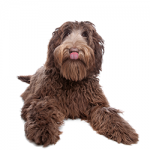Labradoodle or Labrapoo is a designer crossbreed, bred with a Labrador and a Poodle to develop a loyal service dog with hypoallergenic fur. With all crossbreeds, there can be some inconsistencies with breed traits.
Labrapoo Stats
Originally developed to be hypoallergenic guide dogs, the first planned crosses of Poodles and Labrador Retrievers were arranged by the Royal Guide Dogs Association of Australia. The result was a bright and friendly dog who not only possessed a nature appropriate for guide dogs but also had a low-shedding coat.
- Weight -30kg – 45kg
- Size – 55m – 57cm
- They live for 12-15 years
Labradoodle or Labrapoo at a Glance:
Best Labradoodle Trait – Loving
Worst Labradoodle Trait – Boisterous
How Long Do Labradoodles Live For?
10 -14 Years
Are Labradoodles good with kids?
Yes, young and old
What is Labradoodles temperament?
Friendly, wilful, gentle and playful
Do Labradoodles shed a lot?
No, but they need lots of grooming. Invest in a good brush
Do Labradoodles need a lot of exercise?
Yes, at least 1-2 walks per day
More about Labrapoos/Labradoodles
Labradoodles are happy, hardworking, playful and loving dogs. They have the energy of Labrador and the work ethic of both breeds. If you are looking for a dog to fit in with your active family, agility class partner or running companion, this could be your perfect breed.
Exercise
Labradoodles are working dogs. They need a lot of exercise, and this guy is no different. They need plenty of exercise and playtime. They could make the perfect jogging partner. This is not a breed for couch potatoes, and you will need to be able to commit to long walks and endless games to keep them happy. Even though they require a lot of exercise, they are adaptable and could cope with apartment/flat living if their other needs were met.
Children Suitability
Labradoodles are great all-around dogs. They are devoted to you and your family, fantastic and gentle with children of all ages. They are boisterous, so you might want to watch them around younger children.
Guard/Watch Dog
They love strangers, as far as they’re concerned, they are just friends they haven’t met yet! If you are looking for a good watchdog, you need to keep on looking. This breed will most likely lick them to death!
Cats/Small Animals
They are peaceful living and generally run around and play with other dogs. Cats and other small animals in the house should also be OK. Small animals and neighbourhood cats, however, will likely still be chased.
Easy to Train/Intelligence
They are intelligent dogs, but a little stubborn, but they should be reasonably easy to train and work with. Try to keep training exciting and fun for the best results, and avoid being harsh with them. Identifying their motivation and reward early will get you the best results, and it’s nearly always food!
Grooming/Maintenace
Their coats have been mixed; the Labrador is a heavy shedder, and the poodle is a very light shedder. Although they shed less than a Labrador, they still shed moderately throughout the year. There can be a lot of inconsistencies in coats throughout the litter. Labradoodles have unique grooming needs because of their thick, curly or wavy coats, inherited partly from poodles and Labradors.
Regular Brushing
-
Frequency: Ideally every 2–3 days (daily is best for curlier coats).
-
Tools: Slicker brush, comb, or dematting rake.
-
Benefits: Prevents mats and tangles, distributes natural oils, and keeps the coat healthy.
Health
Common problems to keep an eye out for in your labradoodle/labrapoo
Hip and Elbow Dysplasia
-
Cause: Genetic joint disorders causing improper development of hips and elbows.
-
Symptoms: Limping, stiffness, reduced mobility, pain or reluctance to jump, run, or climb stairs.
-
Prevention/Treatment: Maintain ideal weight, moderate exercise, joint supplements, and veterinary care; severe cases may require surgery.
Ear Infections
-
Cause: Labradoodles often have floppy ears that trap moisture, dirt, and bacteria.
-
Symptoms: Frequent scratching or shaking head, ear redness, unpleasant odor, discharge.
-
Prevention/Treatment: Regular cleaning, keeping ears dry after swimming or bathing, and prompt veterinary care for infections.
Skin Allergies and Sensitivities
-
Cause: Labradoodles can inherit sensitive skin prone to allergies from poodles and Labradors.
-
Symptoms: Itching, redness, hot spots, excessive licking or chewing, hair loss, and skin irritation.
-
Prevention/Treatment: High-quality diet, hypoallergenic grooming products, routine skin checks, and veterinary-prescribed medication as needed.
Regular veterinary check-ups, preventive care, and attention to grooming routines can help reduce these common Labradoodle health issues significantly.
Top Female Labradoodle Names:
Luna, Bella, Daisy, Molly, Rosie, Willow, Sadie, Millie, Coco, Ruby
Top Male Labradoodle Names:
Charlie, Teddy, Ollie, Max, Cooper, Archie, Milo, Buddy, Louie, Toby
Cute and Quirky Names:
Noodle, Biscuit, Doodle, Muffin, Waffles, Chewie, Teddy Bear, Ziggy, Bean, Pepper
Nature-Inspired Names:
Maple, Hazel, River, Sunny, Aspen, Clover, Honey, Willow, Bear, Scout
Color-Inspired Names:
Rusty (Apricot/Red), Mocha (Chocolate), Sandy (Golden), Ginger (Red/Apricot), Oreo (Black & White), Cinnamon (Apricot), Shadow (Black), Latte (Cream/Golden), Pepper (Black/Gray)
These names perfectly match a Labradoodle’s friendly, joyful, and affectionate personality.

